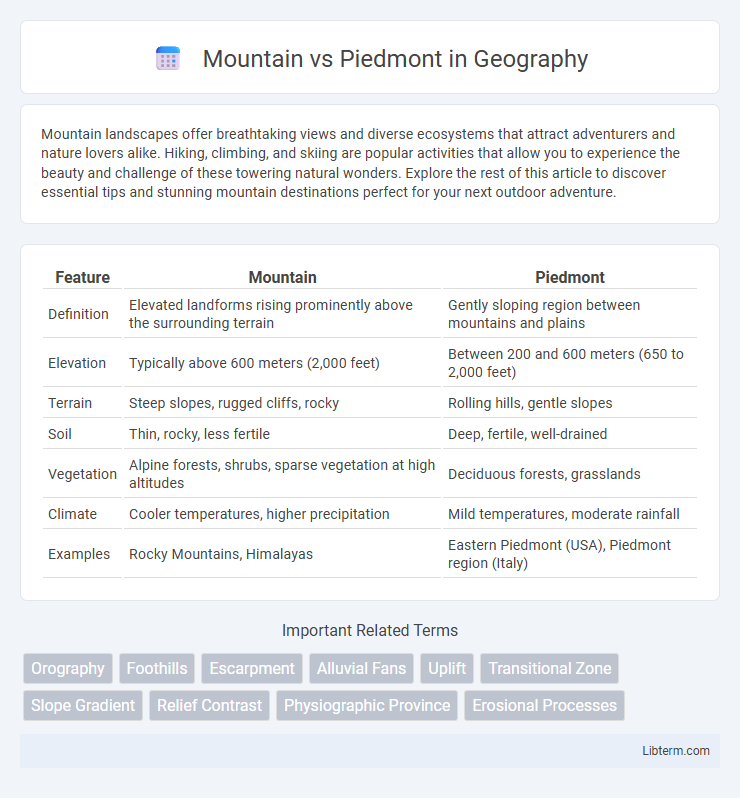Mountain landscapes offer breathtaking views and diverse ecosystems that attract adventurers and nature lovers alike. Hiking, climbing, and skiing are popular activities that allow you to experience the beauty and challenge of these towering natural wonders. Explore the rest of this article to discover essential tips and stunning mountain destinations perfect for your next outdoor adventure.
Table of Comparison
| Feature | Mountain | Piedmont |
|---|---|---|
| Definition | Elevated landforms rising prominently above the surrounding terrain | Gently sloping region between mountains and plains |
| Elevation | Typically above 600 meters (2,000 feet) | Between 200 and 600 meters (650 to 2,000 feet) |
| Terrain | Steep slopes, rugged cliffs, rocky | Rolling hills, gentle slopes |
| Soil | Thin, rocky, less fertile | Deep, fertile, well-drained |
| Vegetation | Alpine forests, shrubs, sparse vegetation at high altitudes | Deciduous forests, grasslands |
| Climate | Cooler temperatures, higher precipitation | Mild temperatures, moderate rainfall |
| Examples | Rocky Mountains, Himalayas | Eastern Piedmont (USA), Piedmont region (Italy) |
Introduction: Understanding Mountains and Piedmonts
Mountains are elevated landforms characterized by steep slopes and significant altitude differences, often formed through tectonic activity and erosion. Piedmont regions lie at the base of mountains, featuring gently sloping hills and rolling terrain that transition from high elevations to flat plains. Understanding the geological processes and ecological distinctions between mountains and piedmonts is key for studying topography and regional climate variations.
Geographic Features: Mountains vs Piedmont
The Mountain region is characterized by rugged terrain with prominent peaks such as the Blue Ridge and Great Smoky Mountains, featuring steep slopes and dense forests. In contrast, the Piedmont region consists of rolling hills and flatlands, formed by ancient eroded mountains, with clay-rich soils and scattered woodlands. These distinct geographic features influence local climate, vegetation, and land use patterns in both regions.
Formation and Geology
The Mountain region, characterized by rugged terrain and high elevations, formed primarily through tectonic plate collisions and volcanic activity, resulting in complex metamorphic and igneous rock formations. In contrast, the Piedmont region developed as a gently rolling plateau composed mostly of eroded sedimentary and metamorphic rocks, shaped by ancient mountain-building events and subsequent erosion. The geology of the Mountain zone features crystalline bedrock and significant fault lines, whereas the Piedmont contains more weathered rock and soil derived from the gradual breakdown of ancient mountains.
Climate Differences
The Mountain region experiences cooler temperatures and higher precipitation due to its elevation, leading to distinct microclimates compared to the Piedmont. In contrast, the Piedmont has a warmer climate with milder winters and hotter summers, influenced by lower altitude and its position between the mountains and coastal plains. These climate differences affect local vegetation, agriculture patterns, and biodiversity within each region.
Flora and Fauna Diversity
The Mountain region exhibits high biodiversity with coniferous forests dominated by species such as Douglas fir, spruce, and pine, supporting wildlife including black bears, mountain lions, and diverse bird species like the northern goshawk. In contrast, the Piedmont boasts mixed hardwood forests with oaks, hickories, and pines, creating habitats for white-tailed deer, eastern box turtles, and a variety of songbirds like the Carolina wren. Differences in elevation and climate drive distinct flora and fauna, with the mountainous areas supporting more cold-tolerant species and the Piedmont promoting species adapted to warmer, temperate conditions.
Economic Activities and Resources
Mountain regions are rich in natural resources such as timber, minerals, and hydroelectric power, driving industries like logging, mining, and energy production. Piedmont areas boast fertile soil and moderate climate, supporting robust agriculture, including vineyards, poultry farming, and textile manufacturing. The Mountain economy relies heavily on resource extraction, while the Piedmont economy benefits from a mix of agriculture and industrial manufacturing.
Human Settlement Patterns
Human settlement patterns in the Mountain region are shaped by rugged terrain and elevation, leading to sparse populations concentrated in valleys and along rivers where resources and accessibility are better. In contrast, the Piedmont region features gently rolling hills and fertile soil, supporting denser populations and extensive urban development due to easier transportation and agricultural opportunities. The Piedmont's proximity to major economic centers further encourages suburban growth, while Mountain settlements remain smaller and more isolated.
Tourism and Recreational Opportunities
The Mountain region offers exceptional tourism with attractions like hiking in the Blue Ridge Mountains and the scenic Blue Ridge Parkway, attracting outdoor enthusiasts year-round. Piedmont provides diverse recreational opportunities including vineyards, golf courses, and historical sites such as the Revolutionary War battlefields, appealing to cultural and leisure tourists. Both regions feature state parks and nature reserves, but the Mountain area emphasizes rugged landscapes and adventure activities, while Piedmont highlights agritourism and accessible urban parks.
Environmental Challenges
The Mountain region faces significant environmental challenges such as soil erosion, deforestation, and the risk of landslides due to steep slopes and heavy rainfall. In contrast, the Piedmont region contends with urban sprawl and agricultural runoff, leading to habitat fragmentation and water pollution. Both areas require targeted conservation strategies to mitigate their distinct ecological impacts and preserve natural resources.
Conclusion: Comparing Mountain and Piedmont Regions
The Mountain region features rugged terrain, higher elevation, and cooler climate compared to the Piedmont's rolling hills and moderate climate. Economic activities in the Mountain region emphasize forestry and tourism, whereas the Piedmont thrives with agriculture, manufacturing, and urban development. Infrastructure and population density are more developed in the Piedmont, reflecting its role as a central hub for commerce and transportation.
Mountain Infographic

 libterm.com
libterm.com